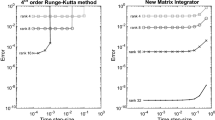Abstract
In this paper, we propose a new splitting algorithm for dynamical low-rank approximation motivated by the fibre bundle structure of the set of fixed rank matrices. We first introduce a geometric description of the set of fixed rank matrices which relies on a natural parametrization of matrices. More precisely, it is endowed with the structure of analytic principal bundle, with an explicit description of local charts. For matrix differential equations, we introduce a first order numerical integrator working in local coordinates. The resulting algorithm can be interpreted as a particular splitting of the projection operator onto the tangent space of the low-rank matrix manifold. It is proven to be exact in some particular case. Numerical experiments confirm this result and illustrate the robustness of the proposed algorithm.










Similar content being viewed by others
Notes
We have been aware of this reference while revising the present paper.
For any \(A \in \mathbb {R}^{n \times m}\), the Moore–Penrose pseudo inverse is given by \(A = (A^TA)^{-1} A^T.\)
Here \(\mathbb {G}_r(\mathbb {R}^p) = \{V_r \subset \mathbb {R}^p : \dim (V_r)=r\}\) denotes the Grassmann manifold.
This means the tangent space to the local parameter space \(\mathbb {R}^{(n-r)\times r}\times \mathbb {R}^{(m-r)\times r} \times \mathbb {R}^{r\times r}\) at (0, 0, G).
For that variant, it means that UG, \(VG^T\) and then G are updated.
References
Bachmayr, M., Eisenmann, H., Kieri E., Uschmajew, A.: Existence of dynamical low-rank approximations to parabolic problems. Mathematics of Computation, AMS Early View articles, preprint (2021)
Billaud-Friess, M., Nouy, A.: Dynamical model reduction method for solving parameter-dependent dynamical systems. SIAM J. Sci. Comput. 39(4), A1766–A1792 (2017)
Billaud-Friess, M., Falcó, A. , Nouy A.: Principal bundle structure of matrix manifolds. Preprint, arXiv:1705.04093 (2017)
Ceruti, G., Lubich C.: Time integration of symmetric and anti-symmetric low-rank matrices and Tucker tensors. Preprint, arXiv:1906.01369 (2019)
Ceruti, G., Lubich ,C.: An unconventional robust integrator for dynamical low-rank approximation Preprint, arXiv:2010.02022 (2020)
Cheng, M., Hou, T.Y., Zhang, Z., Sorensen, D.-C.: A dynamically bi-orthogonal method for time-dependent stochastic partial differential equations I: Derivation and algorithms. J. Comput. Phys. 242, 843–868 (2013)
Falcó, A., Sánchez, F.: Model order reduction for dynamical systems: a geometric approach. Comptes Rendus Mécanique 346(7), 515–523 (2018)
Feppon, F., Lermusiaux, P.F.J.: A geometric approach to dynamical model-order reduction. SIAM J. Matrix Anal. Appl. 39(1), 510–538 (2018)
Feppon, F., Lermusiaux, P.F.J.: Dynamically orthogonal numerical schemes for efficient stochastic advection and Lagrangian transport. SIAM Rev. 60(3), 595–625 (2018)
Feppon, F., Lermusiaux, P.F.J.: The extrinsic geometry of dynamical systems tracking nonlinear matrix projections. SIAM J. Matrix Anal. Appl. 40(2), 814–844 (2019)
Khoromskij, B. N., Oseledets, I., Schneider, R.: Efficient time-stepping scheme for dynamics on TT-manifolds. Preprint (2012)
Kieri, E., Lubich, C., Walach, H.: Discretized dynamical low-rank approximation in the presence of small singular values. SIAM J. Numer. Anal. 54(2), 1020–1038 (2016)
Kieri, E., Vandereycken, B.: Projection methods for dynamical low-rank approximation of high-dimensional problems. Comput. Methods Appl. Math. 19(1), 73–92 (2019)
Koch, O., Lubich, C.: Dynamical low-rank approximation. SIAM J. Matrix Anal. Appl. 29(2), 434–454 (2007)
Lubich, C., Oseledets, I.V.: A projection-splitting integrator for dynamical low-rank approximation. BIT Numer. Math. 54(1), 171–188 (2014)
Musharbash, E., Nobile, F., Zhou, T.: On the dynamically orthogonal approximation of time-dependent random PDEs. SIAM J. Sci. Comput. 37(2), A776–A810 (2015)
Sapsis, T.P., Lermusiaux, P.F.J.: Dynamically orthogonal field equations for continuous stochastic dynamical systems. Physica D 238(23–24), 2347–2360 (2009)
Nonnenmacher, A., C.Lubich, C.: Dynamical low-rank approximation: applications and numerical experiments. Math. Comput. Simul. 79(4), 1346–1357 (2008)
Acknowledgements
This research was funded by the RTI2018-093521-B-C32 grant from the Ministerio de 263 Ciencia, Innovación y Universidades and by the grant number INDI20/13 from Universidad CEU 264 Cardenal Herrera.
Author information
Authors and Affiliations
Corresponding author
Additional information
Communicated by Christian Lubich.
Publisher's Note
Springer Nature remains neutral with regard to jurisdictional claims in published maps and institutional affiliations.
A chart based splitting integrator
A chart based splitting integrator
Following the same lines as in [15], we justify how the chart based method introduced in Sect. 3.1.2 can be interpreted as a splitting scheme relying on the projection decomposition (3.4) as the sum of three contributions \(P_{T_Z(t)}= P_1+ P_2 + P_3 \). One integration step of the splitting method starting from \(t_0\) to \(t_1\) with initial guess \(Z(t_0) = U(t_0)G(t_0)V(t_0)^T\) proceeds as follows.
-
(S1)
Find \(Z \in \mathcal{U}_{Z(t_0)}\) on \([t_0,t_1]\) such that \(\dot{Z} = P_{U} F(Z) P_{V}^T\) with initial condition \(Z(t_0)\).
-
(S2)
Find \(Z \in \mathcal{U}_{Z(t_0)}\) on \([t_0,t_1]\) such that \(\dot{Z} = P_{U}^\perp F(Z) P_{V}^T\) with initial condition given by final condition of step (S1).
-
(S3)
Find \(Z \in \mathcal{U}_{Z(t_0)}\) on \([t_0,t_1]\) such that \(\dot{Z} = P_{U} F(Z) (P^\perp _{V})^T \) with initial condition given by final condition of step (S2).
At each step (Si) of the splitting, Z belongs to the neighborhood of \(Z(t_0)\). Thus it is given by \(Z(t) = U(t)H(t)V(t)^T\) with \(U(t) = U(t_0)+U(t_0)_\perp X(t)\), \(Y(t)= V(t_0)+V(t_0)_\perp Y(t)\) provided by the ODE solved at Step i of the chart based splitting, as stated in the following proposition.
Proposition 5.1
The solution of (S1) is given by Z with
with \(H(t_0)=G(t_0)\), \(X(t_0)=0\) and \(Y(t_0)=0\). Set
-
Letting \(H_1\) be the final condition of H from (S1), the solution of (S2) is given by Z with
$$\begin{aligned} \dot{X} H = {U}_\perp ^+ F (Z)(V^+)^T, \quad \dot{Y}= 0,\quad \dot{H}=0, \end{aligned}$$(A.2)with \(H(t_0)=H_1\), \(X(t_0)=0\) and \(Y(t_0)=0\). Set \(X_1 = X(t_1)\).
-
Letting \(X_1\) be the final condition of X from (S2), the solution of (S3) is given by Z with
$$\begin{aligned} \dot{Y} H^T = {V}_\perp ^+ F (Z) (U^+)^T, \quad \dot{X}= 0,\quad \dot{H}=0, \end{aligned}$$(A.3)with \(H(t_0)=H_1\), \(X(t_0)=X_1\) and \(Y(t_0)=0\).
Proof
For each step (Si), Z admits the decomposition
with derivative
For (S1), the derivative satisfies \(\dot{Z} = P_{U} F(Z) P_{V}^T\). Then, multiplying on the left by \(U(t_0)^+\) and on the right by \((V(t_0)^+)^T\) the matrix \(\dot{Z}\) in both expressions leads to \(\dot{H}= U^+ F(Z) (V^+)^T\) and \(\dot{X} =0, \dot{Y} = 0.\) Now let us turn to (S2). The derivative satisfies \(\dot{Z} = P_{U}^\perp F(Z) P_{V}^T\). By multiplying on the right by \((V(t_0)^+)^T\), the equality is satisfied if \(\dot{X} H = U_\perp ^+ F(Z) (V^+)^T\) and \( \dot{Y}= 0, \dot{H} =0.\) The third point of the lemma is obtained from (S3) in the same manner, by multiplying the equation \(\dot{Z} = P_{U} F(Z) (P_{V}^\perp )^T\) on the left by \((U(t_0)+U(t_0)_\perp X_1)^+\) and setting \(\dot{X} =0\), \(\dot{H}=0\). \(\square \)
Rights and permissions
About this article
Cite this article
Billaud-Friess, M., Falcó, A. & Nouy, A. A new splitting algorithm for dynamical low-rank approximation motivated by the fibre bundle structure of matrix manifolds. Bit Numer Math 62, 387–408 (2022). https://doi.org/10.1007/s10543-021-00884-x
Received:
Accepted:
Published:
Issue Date:
DOI: https://doi.org/10.1007/s10543-021-00884-x




